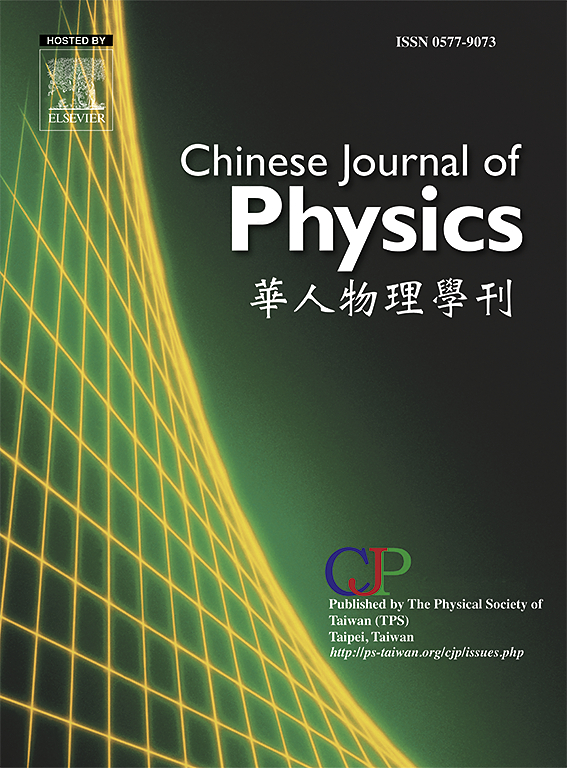非保守重力对大质量致密物体的影响:来自MIT袋模型的见解
IF 4.6
2区 物理与天体物理
Q1 PHYSICS, MULTIDISCIPLINARY
引用次数: 0
摘要
近年来,在非保守引力理论框架下对物理上可行的大质量致密天体的研究引起了天体物理学界的广泛关注。包括现实的物质来源,如麻省理工学院包模型所描述的。在这一分析中,我们探索了静态、各向异性和球对称紧致球的新结构特性,并结合了由MIT袋模型最简单的现象学轮廓所描述的奇异夸克物质的特征。为了实现这一点,我们在宇宙学上完全一致的R+2βT引力模型中推导了修正场方程的一般精确解。这是通过将托尔曼- iv时空作为种子解与袋模型剖面相结合来实现的。袋子常数Bg和其他未知参数由超表面内外几何之间的平滑边界匹配确定。基于这些获得的值,我们根据著名的紧凑型候选恒星4U1608−52的观测数据严格检查和验证了我们的模型解。这是通过测试各种物理条件来实现的,包括时空函数的可行性,物质成分的物理可信度,状态变量的可行性,以及能量条件的实现,以及几个稳定性约束。此外,我们还分析了质量半径关系、紧化系数、表面红移和惯性矩等结构特性,以确保模型的稳定性和物理可靠性。有趣的是,我们的研究预测奇异夸克紧致恒星候选者的最佳质量和紧致度超过了观测数据,为这种替代引力框架提供了强有力的暗示。这表明这样的模型有超越传统观测预测的潜力。最终,我们的发现有力地证实了所提出的结果在物理上是可行的,并且具有良好的一致性,有效地模拟了一个稳定的超密度奇异夸克星,类似于大质量中子星的形成。这些结果为恒星天体物理现象的相对论建模提供了新的见解,强调了不同引力理论和奇异夸克物质分布之间复杂的相互作用。本文章由计算机程序翻译,如有差异,请以英文原文为准。
Impact of non-conservative gravity on massive compact objects: Insights from MIT bag model
In recent years, the investigation of physically viable massive compact objects within the framework of non-conservative theories of gravity has attracted considerable attention from the astrophysical community. The inclusion of realistic matter sources, such as those described by the MIT bag model. In this analysis, we explore new structural properties of a static, anisotropic, and spherically symmetric compact sphere, incorporating the characteristics of strange-quark matter as described by the simplest phenomenological profile of the MIT bag model. To achieve this, we derive a general class of exact solutions to the modified field equations within the cosmologically well-consistent gravity model. This is accomplished by employing the Tolman- spacetime as a seed solution in conjunction with the bag Model profile. The bag constant and other unknown parameters are determined by smooth boundary matching between the interior and exterior geometries at the hypersurface. Based on these obtained values, we rigorously examine and validate our model solutions against observational data from the well-known compact star candidate . This is achieved by testing various physical conditions, including the viability of spacetime functions, the physical credibility of matter components, the feasibility of state variables, and the fulfillment of energy conditions, alongside several stability constraints. Additionally, we analyze structural properties such as the mass–radius relation, compactification factor, surface redshift, and moment of inertia to ensure the model’s stability and physical reliability. Interestingly, our investigation predicts that the optimal mass and compactness of the strange-quark compact star candidate exceed observational data, providing strong implications within this alternative gravity framework. This suggests that such a model has the potential to surpass conventional observational predictions. Ultimately, our findings robustly confirm that the presented outcomes are physically viable and well-consistent, effectively simulating a stable ultra-dense strange-quark star akin to the formation of massive neutron stars. These results offer novel insights into the relativistic modeling of stellar astrophysical phenomena, emphasizing the intricate interplay between alternative gravity theories and strange-quark matter distributions.
求助全文
通过发布文献求助,成功后即可免费获取论文全文。
去求助
来源期刊

Chinese Journal of Physics
物理-物理:综合
CiteScore
8.50
自引率
10.00%
发文量
361
审稿时长
44 days
期刊介绍:
The Chinese Journal of Physics publishes important advances in various branches in physics, including statistical and biophysical physics, condensed matter physics, atomic/molecular physics, optics, particle physics and nuclear physics.
The editors welcome manuscripts on:
-General Physics: Statistical and Quantum Mechanics, etc.-
Gravitation and Astrophysics-
Elementary Particles and Fields-
Nuclear Physics-
Atomic, Molecular, and Optical Physics-
Quantum Information and Quantum Computation-
Fluid Dynamics, Nonlinear Dynamics, Chaos, and Complex Networks-
Plasma and Beam Physics-
Condensed Matter: Structure, etc.-
Condensed Matter: Electronic Properties, etc.-
Polymer, Soft Matter, Biological, and Interdisciplinary Physics.
CJP publishes regular research papers, feature articles and review papers.
 求助内容:
求助内容: 应助结果提醒方式:
应助结果提醒方式:


